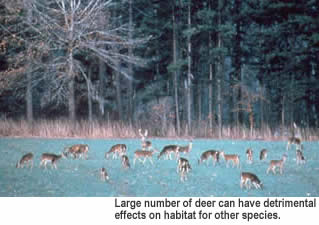Pineywoods Wildlife Management Habitat Management
Gun
White-tailed deer have a high reproduction potential, and in the absence of natural predators, can quickly overpopulate a range. If white-tailed deer are allowed to overpopulate, they can have negative effects on the habitat. Deer consume the most palatable plant species first, and excessive browsing pressure can eliminate these preferred plant species from the range. This reduces plant diversity and can have negative impacts on other wildlife species. Once a range is damaged by overgrazing, it can take years for a range to recover, even after deer numbers are reduced to an appropriate level.

Large herd of white-tailed deer.
The most effective way to regulate deer numbers is through hunting. Hunting allows the land manager to maintain deer numbers at a level that the habitat can support without causing damage to the habitat. In addition to habitat damage, deer from overstocked ranges generally have poor fawn survival, low body weights, and poor antler quality. The most effective way to reduce deer numbers is through the harvest of doe deer at appropriate levels. Once deer numbers are at a desired level, doe harvest must be continued to maintain the population at a desirable level.
Each time a deer hunter chooses to shoot a deer, or not to shoot a deer, a management decision that will affect the future of that deer herd and habitat is made. For example, choosing to shoot, or not to shoot a doe, affects the sex ratio and reproductive potential of the herd. Choosing to shoot, or not to shoot, a yearling buck affects the current and future age structure of the buck population. Therefore, not only can the gun be used to manipulate deer numbers, it can also be used to manipulate sex ratios, reproductive potential, and age structure of the herd.
Another species that can have negative impacts on the habitat is the feral hog, which is considered an exotic. Feral hogs can compete with white-tailed deer for available food sources, such as acorns, thereby increasing the browsing pressure on the range. Feral hogs can also damage sensitive wetland areas as a result of rooting activity. It is recommended that feral hogs be harvested at every opportunity and that protection not be afforded them.
 (
(